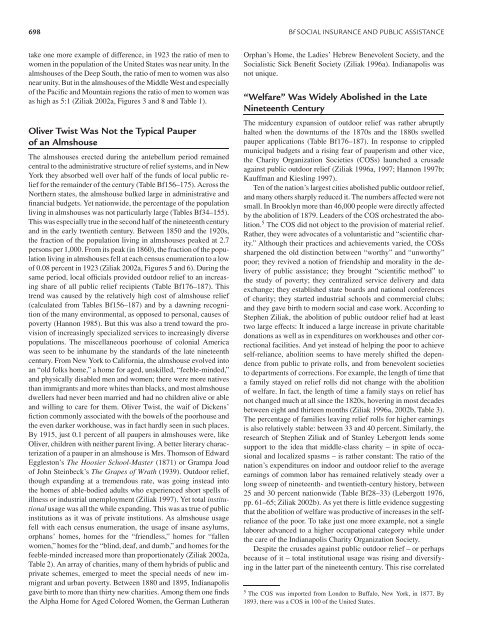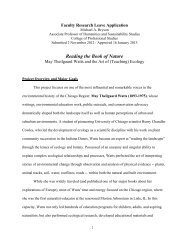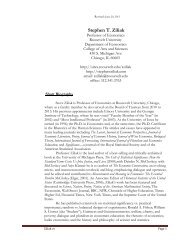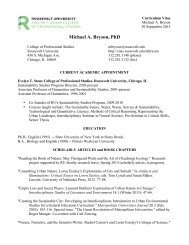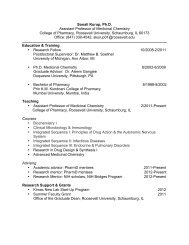Social Insurance and Public Assistance
public-assistance-welfare-reform-colonial-times-to-the-present-ziliak ...
public-assistance-welfare-reform-colonial-times-to-the-present-ziliak ...
You also want an ePaper? Increase the reach of your titles
YUMPU automatically turns print PDFs into web optimized ePapers that Google loves.
698 Bf SOCIAL INSURANCE AND PUBLIC ASSISTANCE<br />
take one more example of difference, in 1923 the ratio of men to<br />
women in the population of the United States was near unity. In the<br />
almshouses of the Deep South, the ratio of men to women was also<br />
near unity. But in the almshouses of the Middle West <strong>and</strong> especially<br />
of the Pacific <strong>and</strong> Mountain regions the ratio of men to women was<br />
as high as 5:1 (Ziliak 2002a, Figures 3 <strong>and</strong> 8 <strong>and</strong> Table 1).<br />
Oliver Twist Was Not the Typical Pauper<br />
of an Almshouse<br />
The almshouses erected during the antebellum period remained<br />
central to the administrative structure of relief systems, <strong>and</strong> in New<br />
York they absorbed well over half of the funds of local public relief<br />
for the remainder of the century (Table Bf156–175). Across the<br />
Northern states, the almshouse bulked large in administrative <strong>and</strong><br />
financial budgets. Yet nationwide, the percentage of the population<br />
living in almshouses was not particularly large (Tables Bf34–155).<br />
This was especially true in the second half of the nineteenth century<br />
<strong>and</strong> in the early twentieth century. Between 1850 <strong>and</strong> the 1920s,<br />
the fraction of the population living in almshouses peaked at 2.7<br />
persons per 1,000. From its peak (in 1860), the fraction of the population<br />
living in almshouses fell at each census enumeration to a low<br />
of 0.08 percent in 1923 (Ziliak 2002a, Figures 5 <strong>and</strong> 6). During the<br />
same period, local officials provided outdoor relief to an increasing<br />
share of all public relief recipients (Table Bf176–187). This<br />
trend was caused by the relatively high cost of almshouse relief<br />
(calculated from Tables Bf156–187) <strong>and</strong> by a dawning recognition<br />
of the many environmental, as opposed to personal, causes of<br />
poverty (Hannon 1985). But this was also a trend toward the provision<br />
of increasingly specialized services to increasingly diverse<br />
populations. The miscellaneous poorhouse of colonial America<br />
was seen to be inhumane by the st<strong>and</strong>ards of the late nineteenth<br />
century. From New York to California, the almshouse evolved into<br />
an “old folks home,” a home for aged, unskilled, “feeble-minded,”<br />
<strong>and</strong> physically disabled men <strong>and</strong> women; there were more natives<br />
than immigrants <strong>and</strong> more whites than blacks, <strong>and</strong> most almshouse<br />
dwellers had never been married <strong>and</strong> had no children alive or able<br />
<strong>and</strong> willing to care for them. Oliver Twist, the waif of Dickens’<br />
fiction commonly associated with the bowels of the poorhouse <strong>and</strong><br />
the even darker workhouse, was in fact hardly seen in such places.<br />
By 1915, just 0.1 percent of all paupers in almshouses were, like<br />
Oliver, children with neither parent living. A better literary characterization<br />
of a pauper in an almshouse is Mrs. Thomson of Edward<br />
Eggleston’s The Hoosier School-Master (1871) or Grampa Joad<br />
of John Steinbeck’s The Grapes of Wrath (1939). Outdoor relief,<br />
though exp<strong>and</strong>ing at a tremendous rate, was going instead into<br />
the homes of able-bodied adults who experienced short spells of<br />
illness or industrial unemployment (Ziliak 1997). Yet total institutional<br />
usage was all the while exp<strong>and</strong>ing. This was as true of public<br />
institutions as it was of private institutions. As almshouse usage<br />
fell with each census enumeration, the usage of insane asylums,<br />
orphans’ homes, homes for the “friendless,” homes for “fallen<br />
women,” homes for the “blind, deaf, <strong>and</strong> dumb,” <strong>and</strong> homes for the<br />
feeble-minded increased more than proportionately (Ziliak 2002a,<br />
Table 2). An array of charities, many of them hybrids of public <strong>and</strong><br />
private schemes, emerged to meet the special needs of new immigrant<br />
<strong>and</strong> urban poverty. Between 1880 <strong>and</strong> 1895, Indianapolis<br />
gave birth to more than thirty new charities. Among them one finds<br />
the Alpha Home for Aged Colored Women, the German Lutheran<br />
Orphan’s Home, the Ladies’ Hebrew Benevolent Society, <strong>and</strong> the<br />
<strong>Social</strong>istic Sick Benefit Society (Ziliak 1996a). Indianapolis was<br />
not unique.<br />
“Welfare” Was Widely Abolished in the Late<br />
Nineteenth Century<br />
The midcentury expansion of outdoor relief was rather abruptly<br />
halted when the downturns of the 1870s <strong>and</strong> the 1880s swelled<br />
pauper applications (Table Bf176–187). In response to crippled<br />
municipal budgets <strong>and</strong> a rising fear of pauperism <strong>and</strong> other vice,<br />
the Charity Organization Societies (COSs) launched a crusade<br />
against public outdoor relief (Ziliak 1996a, 1997; Hannon 1997b;<br />
Kauffman <strong>and</strong> Kiesling 1997).<br />
Tenofthe nation’s largest cities abolished public outdoor relief,<br />
<strong>and</strong> many others sharply reduced it. The numbers affected were not<br />
small. In Brooklyn more than 46,000 people were directly affected<br />
by the abolition of 1879. Leaders of the COS orchestrated the abolition.<br />
5 The COS did not object to the provision of material relief.<br />
Rather, they were advocates of a voluntaristic <strong>and</strong> “scientific charity.”<br />
Although their practices <strong>and</strong> achievements varied, the COSs<br />
sharpened the old distinction between “worthy” <strong>and</strong> “unworthy”<br />
poor; they revived a notion of friendship <strong>and</strong> morality in the delivery<br />
of public assistance; they brought “scientific method” to<br />
the study of poverty; they centralized service delivery <strong>and</strong> data<br />
exchange; they established state boards <strong>and</strong> national conferences<br />
of charity; they started industrial schools <strong>and</strong> commercial clubs;<br />
<strong>and</strong> they gave birth to modern social <strong>and</strong> case work. According to<br />
Stephen Ziliak, the abolition of public outdoor relief had at least<br />
two large effects: It induced a large increase in private charitable<br />
donations as well as in expenditures on workhouses <strong>and</strong> other correctional<br />
facilities. And yet instead of helping the poor to achieve<br />
self-reliance, abolition seems to have merely shifted the dependence<br />
from public to private rolls, <strong>and</strong> from benevolent societies<br />
to departments of corrections. For example, the length of time that<br />
afamily stayed on relief rolls did not change with the abolition<br />
of welfare. In fact, the length of time a family stays on relief has<br />
not changed much at all since the 1820s, hovering in most decades<br />
between eight <strong>and</strong> thirteen months (Ziliak 1996a, 2002b, Table 3).<br />
The percentage of families leaving relief rolls for higher earnings<br />
is also relatively stable: between 33 <strong>and</strong> 40 percent. Similarly, the<br />
research of Stephen Ziliak <strong>and</strong> of Stanley Lebergott lends some<br />
support to the idea that middle-class charity – in spite of occasional<br />
<strong>and</strong> localized spasms – is rather constant: The ratio of the<br />
nation’s expenditures on indoor <strong>and</strong> outdoor relief to the average<br />
earnings of common labor has remained relatively steady over a<br />
long sweep of nineteenth- <strong>and</strong> twentieth-century history, between<br />
25 <strong>and</strong> 30 percent nationwide (Table Bf28–33) (Lebergott 1976,<br />
pp. 61–65; Ziliak 2002b). As yet there is little evidence suggesting<br />
that the abolition of welfare was productive of increases in the selfreliance<br />
of the poor. To take just one more example, not a single<br />
laborer advanced to a higher occupational category while under<br />
the care of the Indianapolis Charity Organization Society.<br />
Despite the crusades against public outdoor relief – or perhaps<br />
because of it – total institutional usage was rising <strong>and</strong> diversifying<br />
in the latter part of the nineteenth century. This rise correlated<br />
5 The COS was imported from London to Buffalo, New York, in 1877. By<br />
1893, there was a COS in 100 of the United States.


